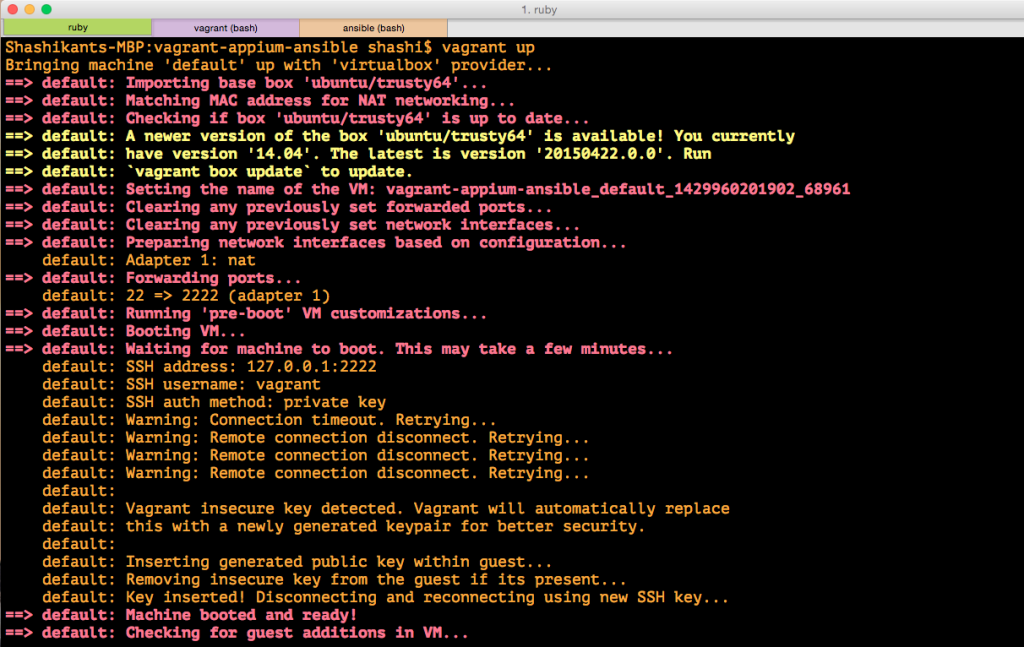
VBoxManage: error: Context: "int handleCreate(HandlerArg*, int, int*)" at line 68 of file VBoxManageHostonly.cpp
Vagrant up code#
VBoxManage: error: Details: code NS_ERROR_FAILURE (0x80004005), component HostNetworkInterface, interface IHostNetworkInterface VBoxManage: error: VBoxNetAdpCtl: Error while adding new interface: failed to open /dev/vboxnetctl: No such file or directory

VBoxManage: error: Failed to create the host-only adapter There was an error while executing `VBoxManage`, a CLI used by Vagrantįor controlling VirtualBox. Occasionally, however, I get errors which prevent me from starting the machine, which halts work all together. Vagrant helps to create an manage a virtual machine that hosts MDN locally. *Any views or opinions in this article are personal and belong to the author(s), and do not represent the official position of Fresh Consulting or its clients.When I'm working on MDN's source, kuma, I use a technology called Vagrant to do so. Once this initial setup is complete, you’ll be able to hand off your environment to any developer/designer, and with one simple command they can be up and running with an exact replica of your environment, dramatically reducing onboarding and setup time for growing and evolving teams. Now is when the real fun starts: Ansible playbooks and deep-dive configuration are at your fingertips. Shell: curl -sS | php & mv composer.phar /usr/local/bin/composer This example calls provisioning/vagrant.yml, which does a very basic installation of common packages on a Ubuntu Linux server: # vim:ft=ansible:

Now the configuration magic happens in your Ansible playbooks, which you’ll be creating in your provisioning directory. # -*- mode: ruby -*-Ĭonfig.vm.network "private_network", ip: ip_addressĬonfig.vm.provision "ansible" do |ansible|Īaybook = "provisioning/vagrant.yml" Take this Vagrantfile for example, and run with it.
Vagrant up how to#
Here’s how to build a development environment on UBUNTU 14.04 with a traditional LEMP stack.įirst, install all the necessary software:Īt this point you have all the tools necessary to get started! Let’s first break down the primary components and explain what we’re doing.
Vagrant up windows#
The idea behind Vagrant is that the same scripts and/or tools used to provision and “launch” development environments are used to launch your production environments, keeping the two as close to identical as possible.Ĭhef, Puppet, Salt, Ansible, and other tools are used alongside Vagrant to make this utopian scenario come to life, and speaking from experience I can assure skeptical system administrators that it is possible! Where Do I Start?Ī computer with Linux, OSX, or Windows installed is all you need to implement Vagrant and get your development environment up and running in seconds.

Have you ever been a manager and heard a team member say, “I don’t know why, it worked locally!”ĭo you travel and wish you could work on the road away from your primary workstation without sacrificing components of your development environment?ĭo you need to give a demo and can’t access your staging/demo server for whatever reason? Imagine being able to spin up a demo server on any workstation in seconds. Have you ever had to change workstations and needed to work on your project? Remember how long it took to get to a point where you could actually get to work?

Leveraging other tools for core components like virtualization and configuration, Vagrant combines the vital parts of your application into a simple command that will get anyone on your team, on any workstation up and working in moments. Vagrant is a tool for building and managing development environments with a heavy focus on configuration, and most importantly on automation. I have been a part of or managed teams of developers for the last twelve years, and I’ve seen the benefits of Vagrant Up increase the efficiency and flexibility of development projects, even for a one-person team.
Vagrant up portable#
Since then Vagrant has aimed to do one thing very well: “Create and configure lightweight, reproducible, and portable development environments.” You might be wondering why this is important, or how additional steps and yet more apps and “things” to install can be anything but a pain for a development team. Vagrant was originally a simple product and brainchild of Mitchell Hashimoto but has rapidly grown into a full-fledged enterprise-supported platform for application development. Have you ever managed a remote team and needed to get developers or designers set up so they could start contributing to a project? How many hours (or days!) do you wish you could get back?Įarlier this year Hashicorp released a product that changed the face of team-based development.


 0 kommentar(er)
0 kommentar(er)
